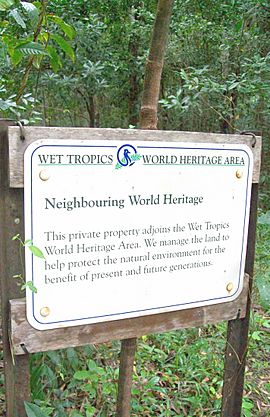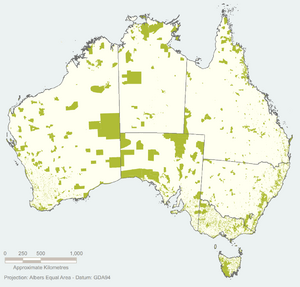National Reserve System facts for kids
Quick facts for kids National Reserve SystemAustralia |
|
|---|---|

A sign in the Wet Tropics of Queensland, part of the National Reserve System
|
|
| Established | 1992 |
| Area | > 137 million hectares (340×106 acres) |
| Managing authorities |
|
| Website | National Reserve System |
Australia's National Reserve System (NRS) is a huge network of protected areas. It includes over 10,000 special places across the country. These places are managed by the Australian Government and by different states and territories.
Together, these areas protect more than 137 million hectares. That's over 17% of Australia's land! The main goal of the NRS is to protect Australia's amazing variety of plants, animals, and natural landscapes. It also helps preserve important cultural sites for future generations.
To help plan where to protect land, a special tool was created. It's called the Interim Biogeographic Regionalisation for Australia (IBRA). This tool helps identify important areas that need protection.
Contents
How the National Reserve System Started
The idea for the National Reserve System came from an international agreement. This agreement is called the Convention on Biological Diversity. Australia signed and agreed to this convention in 1992. This meant Australia promised to help protect the world's natural diversity.
After signing, the Prime Minister at the time, Paul Keating, made an important announcement. He said that creating a complete system of protected areas was vital. This would help Australia keep its status as a place with many different species. He also said these areas needed to protect all kinds of ecosystems. The government promised to work with the states and territories to make this happen.
Early Steps and Growth
In the first four years, from 1992 to 1996, a lot of work was done. About $11.2 million was spent to set up the system. With help from all the states and territories, 5,600 properties were added. These covered almost 60 million hectares.
A new program also started called the Indigenous Protected Area (IPA) program. This program helps protect valuable natural areas on land owned by Indigenous Australians. By 2003, 17 Indigenous Protected Areas were officially declared. These added a lot to the National Reserve System.
Over the next ten years, from 1996 to 2007, even more land was added. Another 30 million hectares joined the system. Two-thirds of this new land came from Indigenous Protected Areas.
In 1999, Tasmania started a new way to create protected areas. They worked with private landowners to protect their land. By 2005, all states and territories agreed again to keep working together. They called the NRS a national "flagship in biodiversity conservation." This means it's a leading example of protecting nature.
What's Happening Now
The National Reserve System is still a top priority for the Australian Government. They continue to provide money to protect more areas. They focus on places that don't have much protection yet. This includes areas like the sub-tropical savanna in northern Australia. It also includes the Mitchell grass country in Queensland and dry central Australia.
The government also keeps investing in Indigenous Protected Areas. A new plan for the NRS is being developed. This plan will identify what needs to be done over the next 20 years.
Why the National Reserve System is Important
Many groups think the National Reserve System is a great success. The WWF Australia has praised it as a good way to protect nature. They say it's also cost-effective, meaning it's a good use of money.
Scientists from CSIRO have also studied the NRS. Their research shows that the NRS will be very important. It will help Australia's environment deal with the effects of climate change in Australia. It helps protect nature from the changing climate.


